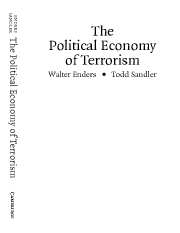Book contents
- Frontmatter
- Contents
- List of Tables and Figures
- Preface
- 1 Terrorism : An Introduction
- 2 The Dilemma of Liberal Democracies
- 3 Statistical Studies and Terrorist Behavior
- 4 Counterterrorism
- 5 Transference
- 6 International Cooperation : Dilemma and Inhibitors
- 7 Hostage Taking
- 8 After 9/11
- 9 The Economic Impact of Transnational Terrorism
- 10 Homeland Security
- 11 The Future of Terrorism
- References
- Author Index
- Subject Index
3 - Statistical Studies and Terrorist Behavior
Published online by Cambridge University Press: 06 July 2010
- Frontmatter
- Contents
- List of Tables and Figures
- Preface
- 1 Terrorism : An Introduction
- 2 The Dilemma of Liberal Democracies
- 3 Statistical Studies and Terrorist Behavior
- 4 Counterterrorism
- 5 Transference
- 6 International Cooperation : Dilemma and Inhibitors
- 7 Hostage Taking
- 8 After 9/11
- 9 The Economic Impact of Transnational Terrorism
- 10 Homeland Security
- 11 The Future of Terrorism
- References
- Author Index
- Subject Index
Summary
Our eyes are wonderful at detecting associations in data because our brains are wired to simplify complicated patterns and relationships. Within a few seconds, you should be able to figure out that 25 is the next number in the sequence 1, 4, 9, 16. A computer program may need to make millions of calculations just to detect a pattern in the chess pieces that is readily visible to an accomplished player. The problem is that the patterns we perceive in the data may not meaningfully characterize its actual behavior. In the same way that our brains are able to “see” elaborate paintings in the clouds, we are sometimes able to “recognize” what are spurious relationships in economic data.
This chapter will present the time plots of various types of terrorist incidents, including bombings, assassinations, kidnappings, and skyjackings. Some features of the data will be clear even to the casual observer; for example, there is no decidedly upward trend in any of the incident series. However, many other features of the data may not be readily apparent, so that statistical analysis is required to draw inferences about the data. Toward this end, the chapter uses the basic tools of spectral analysis and intervention analysis to formally analyze data about terrorist incidents. Spectral analysis enables us to estimate the cyclical patterns in the various terrorist incident series, while intervention analysis allows us to measure the effects of important structural changes on the incident series.
- Type
- Chapter
- Information
- The Political Economy of Terrorism , pp. 52 - 83Publisher: Cambridge University PressPrint publication year: 2005

